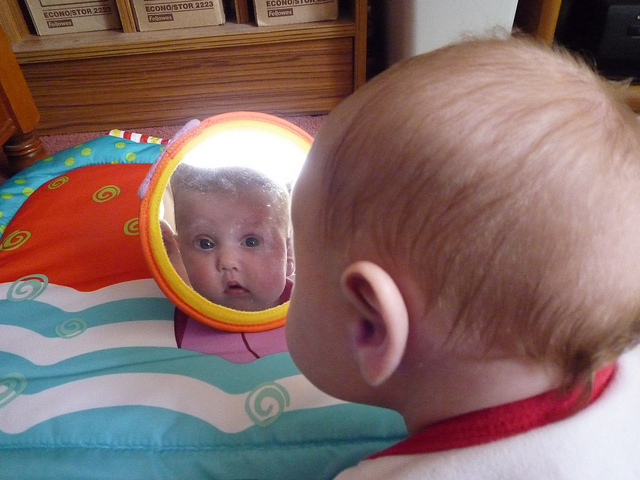Archive for the ‘Intellectual Intertia’ Category
The Ladder Of Your Own Making
 There’s a natural hierarchy to work. Your job, if you choose to accept it is to climb the ladder of hierarchy rung-by-rung. Here’s how to go about it:
There’s a natural hierarchy to work. Your job, if you choose to accept it is to climb the ladder of hierarchy rung-by-rung. Here’s how to go about it:
Level 1. Work you can say no to – Say no to it. Say no effectively as you can, but say it. Saying no to level 1 work frees you up for the higher levels.
Level 2. Work you can get someone else to do – Get someone else to do it. Give the work to someone who considers the work a good reach, or a growth opportunity. This isn’t about shirking responsibility, it’s about growing young talent. Maybe you can spend a little time mentoring and the freed up time doing higher level work. Make sure you give away the credit so next time others will ask you for the opportunity to do this type of work for you.
Level 3. Work you’ve done before, but can’t wiggle out of – Do it with flair, style, and efficiency; do it differently than last time, then run away before someone asks you to do it again. Or, do it badly so next time they ask someone else to do it. Depending on the circumstance, either way can work.
Level 4. Work you haven’t done before, but can’t wiggle out of – Come up with a new recipe for this type of work, and do it so well it’s unassailable. This time your contribution is the recipe; next time your contribution is to teach it to someone else. (See level 2.)
Level 5. Work that scares others – Figure out why it scares them; break it into small bites; and take the smallest first bite (so others can’t see the failure). If it works, take a bigger bite; if it doesn’t, take a different smallest bite. Repeat, as needed. Next time, since you’ve done it before, treat it like level 3 work. Better still, treat it like level 2.
Level 6. Work that scares you – Figure out why it scares you, then follow the steps for level 5.
Level 7. Work no one knows to ask you to do – You know your subject matter better than anyone, so figure out the right work and give it a try. This flavor is difficult because it comes at the expense of work you’re already signed up to do and no one is asking you to do it. But you should have the time because you followed the guidance in the previous levels.
Level 8. Work that obsoletes the very thing that made your company successful – This is rarified air – no place for the novice. Ultimately, someone will do this work, and it might as well be you. At least you’ll be able to manage the disruption on your own terms.
In the end, your task, if you choose to accept it, is to migrate toward the work that obsoletes yourself. For only then can you start back at level 1 on the ladder of your own making.
Summoning The Courage To Ask
I’ve had some great teachers in my life, and I’m grateful for them. They taught me their hard-earned secrets, their simple secrets. Though each had their own special gifts, they all gave them in the same way – they asked the simplest questions.
Today’s world is complex – everything interacts with everything else; and today’s pace is blistering – it’s tough to make time to understand what’s really going on. To battle the complexity and pace, force yourself to come up with the simplest questions. Here are some of my favorites:
For new products:
- Who will buy it?
- What must it do?
- What should it cost?
For new technologies:
- What problem are you trying to solve?
- How will you know you solved it?
- What work hasn’t been done before?
For new business models:
- Why are you holding onto your decrepit business model?
For problems:
- Can you draw a picture of it on one page?
- Can you make it come and go?
For decisions:
- What is the minimum viable test?
- Why not test three or four options at the same time?
For people issues:
- Are you okay?
- How can I help you?
For most any situation:
- Why?
These questions are powerful because they cut through the noise, but their power couples them to fear and embarrassment – fear that if you ask you’ll embarrass someone. These questions have the power to make it clear that all the activity and hype is nothing more than a big cloud of dust heading off in the wrong direction. And because of that, it’s scary to ask these questions.
It doesn’t matter if you steal these questions directly (you have my permission), twist them to make them your own, or come up with new ones altogether. What matters is you spend the time to make them simple and you summon the courage to ask.
Image credit — Montecruz Foto.
Can It Grow?
 If you’re working in a company you like, and you want it to be around in the future, you want to know if it will grow. If you’re looking to move to a new company, you want to know if it has legs – you want to know if it will grow. If you own stock, you want to know if the company will grow, and it’s the same if you want to buy stock. And it’s certainly the case if you want to buy the whole company – if it can grow, it’s worth more.
If you’re working in a company you like, and you want it to be around in the future, you want to know if it will grow. If you’re looking to move to a new company, you want to know if it has legs – you want to know if it will grow. If you own stock, you want to know if the company will grow, and it’s the same if you want to buy stock. And it’s certainly the case if you want to buy the whole company – if it can grow, it’s worth more.
To grow, a company has to differentiate itself from its competitors. In the past, continuous improvement (CI) was a differentiator, but today CI is the minimum expectation, the cost of doing business. The differentiator for growth is discontinuous improvement (DI).
With DI, there’s an unhealthy fascination with idea generation. While idea generation is important, companies aren’t short on ideas, they’re short on execution. But the one DI differentiator is the flavor of the ideas. To do DI a company needs ideas that are radically different than the ones they’re selling now. If the ideas are slightly twisted variants of today’s products and business models, that’s a sure sign continuous improvement has infiltrated and polluted the growth engine. The gears of the DI engine are gummed up and there’s no way the company can sustain growth. For objective evidence the company has the chops to generate the right ideas, look for a process that forces their thinking from the familiar, something like Jeffrey Baumgartner’s Anticonventional Thinking (ACT).
For DI-driven growth, the ability to execute is most important. With execution, the first differentiator is how the company investigates radically new ideas. There are three differentiators – a focus on speed, a “market first” approach, and the use of minimum viable tests (MVTs). With new ideas, it’s all about how fast you can learn, so speed should come through loud and clear. Without a market, the best idea is worthless, so look for “market first” thinking. Idea evaluation starts with a hypothesis that a specific market exists (the market is clearly defined in the hypothesis) which is evaluated with a minimum viable test (MVT) to prove or disprove the market’s existence. MVTs should error on the side of speed – small, localized testing. The more familiar minimum viable product (MVP) is often an important part of the market evaluation work. It’s all about learning about the market as fast as possible.
Now, with a validated market, the differentiator is how fast company can rally around the radically new idea and start the technology and product work. The companies that can’t execute slot the new project at the end of their queue and get to it when they get to it. The ones that can execute stop an existing (lower value) project and start the new project yesterday. This stop-to-start behavior is a huge differentiator.
The company’s that can’t execute take a ready-fire-aim approach – they just start. The companies that differentiate themselves use systems thinking to identify gaps in resources and capabilities and close them. They do the tough work of prioritizing one project over another and fully staff the important ones at the expense of the lesser projects. Rather than starting three projects and finishing none, the companies that know how to do DI start one, finish one, and repeat. They know with DI, there’s no partial credit for a project that’s half done.
All companies have growth plans, and at the highest level they all hang together, but some growth plans are better than others. To judge the goodness of the growth plan takes a deeper look, a look into the work itself. And once you know about the work, the real differentiator is whether the company has the chops to execute it.
Image credit – John Leach.
An Injection Of Absurdity
Things are cyclic, but there seems to be no end to the crusade of continuous improvement. (Does anyone remember how the Crusades turned out?) If only to take the edge off, there needs to be an injection of absurdity.
There’s no pressure with absurdity – no one expects an absurd idea to work. If you ask for an innovative idea, you’ll likely get no response because there’s pressure from the expectation the innovative idea must be successful. And if you do get a response, you’ll likely get served a plain burrito of incremental improvement garnished with sour cream and guacamole to trick your eye and doused in hot sauce to trick your palate. If you ask for an absurd idea, you get laughter and something you’ve never heard before.
When drowning in the sea of standard work, it takes powerful mojo to save your soul. And the absurdity jetpack is the only thing I know with enough go to launch yourself to the uncharted oasis of new thinking. Immense force is needed because continuous improvement has serious mass – black hole mass. Like with light, a new idea gets pulled over the event horizon into the darkness of incremental thinking. But absurdity doesn’t care. It’s so far from the center lean’s pull is no match.
But to understand absurdity’s superpower is to understand what makes things absurd. Things are declared absurd when they cut against the grain of our success. It’s too scary to look into the bright sun of our experiences, so instead of questioning their validity and applicability, the idea is deemed absurd. But what if the rules have changed and the fundamentals of last year’s success no longer apply? What if the absurd idea actually fits with the new normal? In a strange Copernican switch, holding onto to what worked becomes absurd.
Absurd ideas sometimes don’t pan out. But sometimes they do. When someone laughs at your idea, take note – you may be on to something. Consider the laughter an artifact of misunderstanding, and consider the misunderstanding a leading indicator of the opportunity to reset customer expectations. And if someone calls your idea absurd, give them a big hug of thanks, and get busy figuring out how to build a new business around it.
Retreating From Activity To Progress
 Every day is a meeting-to-meeting sprint with no time for some of the favorite fundamentals like the bathroom and food. Though crazy, it’s the norm and no longer considered crazy. But it is crazy. When you’re too busy to answer emails that’s one thing, but when you’re too busy to realize answering email isn’t progress, that’s a problem.
Every day is a meeting-to-meeting sprint with no time for some of the favorite fundamentals like the bathroom and food. Though crazy, it’s the norm and no longer considered crazy. But it is crazy. When you’re too busy to answer emails that’s one thing, but when you’re too busy to realize answering email isn’t progress, that’s a problem.
Our in-boxes are full; our plates are full; our calendars are full. But our souls are empty.
You’re clear on what must get done over the next 48 hours, but the pace is too fast to know why the work is important in the first place. (One of the fastest way to complete a task is to deem it unimportant and don’t do it – all of the done with none of the work.) But it’s worse. It’s too fast to do the work no one is asking you to do, and it’s too fast to do the work you were born to do.
We have confused activity with progress; and with all the activity, we’ve forgotten what it feels like to think. We need a retreat.
The perfect retreat eliminates distractions and gives people time to think. After a nice Sunday flight into Boston, it’s a calm two hour coach ride to rural New Hampshire. (Done right, a coach is soothing.) After pickup it’s a fifteen minute drive to a remote trail head. With a pack on your back, it’s a five minute walk to a big, remote cabin. No cell service, no power, no interruptions.
As you enter the cabin, you unload all your electronics into bin (Yes, your smart phone goes in the bin.) which is locked away for the remainder of the retreat. You race to get the best bunk, drop your gear, and share a meal with your fellow over achievers. (Y es, the non-disclosures are signed so you can actually talk to each other.)
The first day is all about recognizing the discomfort that comes with no distractions and your natural tendency to create distraction to sooth your discomfort. The objective is to help you remember what if feels like to have more than 30 seconds of uninterrupted time. Then, once you remember, it’s time to actually think.
There are no video conferencing capabilities (or electricity) in the cabin, so all work is done the old-fashioned way – face-to-face. The objective is to help you remember the depth, complexity, and meaning that come when working with actual faces. Yes, there’s good facilitated discussion, but the topics aren’t as important as remembering how to share and trust.
There is ritualistic work of cooking, cleaning, splitting the wood, and stoking the fire. The objective is to remember what it feels like to connect the mind to the body and to connect with others. And, there’s a group hike every day to remember what it feels like to be grounded in the natural world. (Sometimes we forget the business world is actually part of the natural world.)
After the rituals and hikes have done their magic, the right discussions start to emerge, and deep contemplation dances with deep conversation. Though there’s a formal agenda, no matter. With the group’s awaking, the right agenda emerges.
At the end of the retreat, there’s immense sadness. This is a sign of importance and deep learning. And after the hugs and tears, there’s a spontaneous commitment to do it next year. With eyes dried, it’s off the bus station and then to the airport.
You don’t have to wait for the perfect retreat to start your journey. Start your practice by carving out an hour a day and set a recurring meeting with yourself and turn off your email. And start by asking yourself why. Those two tricks will set you on your way.
And if you’re interested in a real retreat, let me know.
Slower Can Be Faster
 There are two types of drivers – those that speed as a way of life and those that speed when they forget to pay attention. But for both, speed kills.
There are two types of drivers – those that speed as a way of life and those that speed when they forget to pay attention. But for both, speed kills.
For the everyday speeder, life is an opportunity to push limits and break rules. Every highway is a Formula One course; every traffic light an opportunity to run the red light. They know every speed trap and have honed their drag racing tactics, and, mostly, they don’t get caught. And driving this way year-on-year, they no longer realize they’re speeding and no longer see it as dangerous behavior. They see themselves as invincible and even take pride in their reckless behavior, and that’s dangerous.
If you’ve made the product before, or you’ve done something similar, you know all the traps and a fast business decision isn’t bad. But fast all the time isn’t the answer. When you’re in country that drives on the wrong side of the road and you approach a round-about, slower is better. When you don’t understand the road signs; when your left-right decisions are backward; and you don’t know how to negotiate the big circle of traffic, it’s pretty clear slower is better. But if you’ve been successful with your habitual speeding, you’ll likely accelerate into the traffic circle, rear-end someone, and flip yourself end others into a deadly pileup. And if you survive, likely curse those stupid drivers who didn’t know enough to get out of your way.
But there’s a simpler case that seals it. When you don’t know where you’re going, clicking off miles on the odometer isn’t progress, it’s just activity (that burns fuel). In these conditions, going fast in the wrong directions is worse than not driving at all. When you’re lost, it doesn’t make sense to speed.
The conscientious speeder keeps two hands on the wheel and maintain safe separation distance at upwards of ten car lengths. For them, every day is an opportunity to check the tire pressure and check the dipstick for oil. They plan out the trip, check the road conditions, and pay attention. (Cell phones off for these folks.)
Today’s cars are quiet and smooth which makes for calm, comfortable driving. But they’re also powerful, and, even with good intentions, a brief lapse in attention can generate breakneck speed. The conscientious speeder backs off the accelerator as soon as attention returns, and the danger is low. But, when a lapse in attention overlaps with a quick change in driving conditions (a deer runs across the highway, or the car in front jacks on the breaks), you can’t react quickly enough, and that’s dangerous.
If you’ve made the product before, or you’ve done something similar, and you checked the tire pressure, a lapse in attention once in a while isn’t bad. But doing the same drive every day and lulling yourself into a road trip stupor isn’t the answer. When you’re cruising over the limit on a well-lit, dead-straight highway, in your serenity you can easily speed past your exit without knowing. And the faster you’re going, the more exits you’ll miss until you realize it.
Sometimes, when the conditions are right, slower is faster.
Decide To Tackle The Impossible
 Doing the impossible doesn’t take a long time, starting does. More precisely, what takes a long time is getting ready to start. Getting ready is the gating item. So what’s in the way?
Doing the impossible doesn’t take a long time, starting does. More precisely, what takes a long time is getting ready to start. Getting ready is the gating item. So what’s in the way?
The big deal about starting is other people will see you do it and they’ll judge you. Your brain tells stories about how people will think you’re silly or incompetent for trying the outrageous. It takes a long time to build the courage to start. But where starting is scary, getting ready is safe and comfortable. Getting ready is done in the head – it’s a private process. And because you do it in your head, you can do it without being judged, and you can do it for as long as you like. And you can take comfort in getting ready because you rationalize you’re advancing the ball with your thinking. (Hey, at least you’re thinking about it.) But the real reason for staying in the getting ready domain is starting the fear around being judged for starting.
After you finally mustered the courage to start, you’ll get welcomed with all sorts of well-intentioned, ill-informed criticism. The first one – We tried that before, and it didn’t work. Thing is, it was so long ago no one remembers what was actually tried. Also, no one remembers how many approaches were tried, and even fewer know why it didn’t work. But, everyone’s adamant it won’t work because it didn’t work. Your response – That was a long time ago, and things have changed since then. There are new technologies to try, new materials that may work, new experimental methods, and new analytical methods to inform the work.
Now that you dismissed the we-already-tried-that’s, the resource police will show up at your door. They’ll say – That’s a huge project and it will consume all our resources. You can’t do that. Your response – Well, I’m not eating the whole enchilada, I only taking the right first bite. And for that, I don’t need any extra resources. You see, my friends and I really want to do this and we pooled our resources and narrowly defined the first bite. So, as far as resources, I’m all set.
Now the alignment officers will find you. They’ll say – Your off-topic mission impossible will confuse and distract our organization and we can’t have that. You know there’s no place for passion and excitement around here. Can you imagine engineers running around doing things that could disrupt our decrepit business model? We’ll no longer have control, and we don’t like that. Please stop. Your response – Let’s set up a meeting with the CEO who’s on the hook to create new businesses, and you can deliver that message face-to-face. You want me to set up the meeting?
Lastly, the don’t-rock-the-boaters will nip at your heels. They’ll say – Things are going pretty well. Did you hear we’re laying off fewer people this quarter? And, we’re losing less money this quarter. Things are looking up. And here you are trying something new, and scaring everyone half to death. You’ve got to stop that nonsense. Your response – Though it may be scary, I have a hunch this crazy stuff could create a whole new business and help secure the company’s future. And I have kids going to college in a couple years, and the company’s future is important to me.
When doing the impossible, the technical part is the easy part. Once you decide to try, what you thought impossible comes quickly. What’s difficult is the people part. Doing the impossible is unpredictable, and it cuts across grain of our culture of predictability. For years it’s been well defined projects with guaranteed profits and completion dates etched in stone. And after years of predictability injections people become the antibodies that reject the very work the company needs – the work that delivers the impossible.
No kidding – once you start the impossible, your organization will make it difficult for you. But, that’s nothing compared to the difficulty of getting ready because in that phase, you must overcome the most powerful, sly, dangerous critic of all – yourself.
The Parent of Learning
 Hypothesis is a charged word – It has a scientific color; it smacks of sterility; it is thought to be done by academics; and it’s sometimes classified as special class of guessing. In thought and action, hypothesis is misunderstood.
Hypothesis is a charged word – It has a scientific color; it smacks of sterility; it is thought to be done by academics; and it’s sometimes classified as special class of guessing. In thought and action, hypothesis is misunderstood.
We twist the word so it doesn’t apply in our situation; we label it to distance ourselves; we tag it with snarl connotations to protect ourselves. We do this because we’re afraid of the word’s power.
Replace hypothesis with “I think this will happen – [fill in the blank.]” and it’s clear why we’re afraid. Hypothesis, as an activity, has the power to make it clear to everyone that you really don’t know what’s going on. Hypothesis demands you speculate based on your knowledge, and the fear is when you’re wrong (and you will be) people will think your knowledge (and you) is of a meager kind. Hypothesis demands you put yourself out there for the world to see. And that’s why it’s rarely done. And since it’s rarely done, its benefits are not understood.
Innovation is all the rage these days, and innovation is all about learning. And where necessity is the mother of invention, hypothesis is the father of learning. Hypothesis breeds learning by providing a comparison between what you thought would happen and what happened. The difference is a measure of your knowledge; and how the difference changes over time is a measure of your learning. If the difference widens over time, you’re getting cold; if it stays constant, you’re treading water; and if it converges, you’re learning.
Like a good parent, hypothesis knows which rules can be bent and which won’t be compromised. In the hypothesis household clarity and honesty are not optional – clarity around the problem at hand; clarity around how you’ll test and measure; and honesty around the limits of your knowledge.
Learning is important – no one can argue – and learning starts with a hypothesis. More strongly, learning is so important you should work through your fear around hypothesis and increase your learning rate.
Really, hypothesis isn’t the stern parent you think. Hypothesis will make time to teach you to ride your bike without training wheels, and be right there to bandage your skinned knees.
And, like a good parent, if you ask hypothesis for help, I think this will happen – [you’ll learn more and learn faster.]
Tracking Toward The Future
 It’s difficult to do something for the first time. Whether it’s a new approach, a new technology, or a new campaign, the mass of the past pulls our behavior back toward itself. And sadly, whether the past has been successful or not, its mass, and therefore it’s pull, are about the same. The past keeps us along the track of sameness.
It’s difficult to do something for the first time. Whether it’s a new approach, a new technology, or a new campaign, the mass of the past pulls our behavior back toward itself. And sadly, whether the past has been successful or not, its mass, and therefore it’s pull, are about the same. The past keeps us along the track of sameness.
Trains have tracks to enable them to move efficiently (cost per mile), and when you want to go where the train is heading, it’s all good. But when the tracks are going to the wrong destination, all that efficiency comes at the expense of effectiveness. Like we’re on rails, company history keeps us on track, even if it’s time for a new direction.
The best trains run on a ritualistic schedule. People queue up at same time every morning to meet their same predictable behemoth, and take comfort in slinking into their regular seats and turning off their brains. And this is the train’s trick. It uses its regularity to lull riders into a hazy state of non-thinking – get on, sit down, and I’ll get your there – to blind passengers from seeing its highly limited timetable and its extreme inflexibility. The train doesn’t want us to recognize that it’s not really about where the train wants to go.
Trains are powerful in their own right, but their real muscle comes from the immense sunk cost of their infrastructure. Previous generations invested billions in train stations, repair facilities, tight integration with bus lines, and the tracks, and it takes extreme strength of character to propose a new direction that doesn’t make use of the old, tired infrastructure that’s already paid for. Any new direction that requires a whole new infrastructure is a tough sell, and that’s why the best new directions transcend infrastructure altogether. But for those new directions that require new infrastructure, the only way to go is a modular approach that takes the right size bites.
Our worn tracks were laid in a bygone era, and the important destinations of yesteryear are no longer relevant. It’s no longer viable to go where the train wants; we must go where we want.
It Can’t Be Innovation If…
Companies strive for predictability, yet if it’s predictable, it cannot be innovation.
We seek comfort in our work, but if it’s comfortable it can’t be innovation.
Businesses like to grow by selling more to the customers we have, but if existing customers can recognize it, it can’t be innovation.
We want to meet year end numbers, but if the project will generate profit in the year it begins, it can’t be innovation.
We love our standardized processes, but if it’s standard, it cannot be innovation.
If there’s consensus, it’s not innovation.
If the project isn’t wreaking havoc with your organizational norms, it can’t be innovation.
If the market already exists, it can’t be innovation.
If you’ve done it before, it can’t be innovation.
If you are following a best practice, it can’t be innovation.
If there’s a high probability it will work, it can’t be innovation.
If people aren’t threatened, it can’t be innovation.
What Aren’t You Doing?
You’re busier than ever, and almost every day you’re asked to do more. And usually it’s more with less – must improve efficiency so you can do more of what you already do. We want you to take this on, but don’t drop anything.
Improving your efficiency is good, and it’s healthy to challenge yourself to do more, but there’s a whole other side to things – a non-efficiency-based approach, where instead of asking how can you do more things, it’s about how you can do things that matter more.
And from this non-efficiency-based framework, the question “What aren’t you doing?” opens a worm hole to a new universe, and in this universe meaning matters. In this universe “What aren’t you doing?” is really “What aren’t you doing that is truly meaningful to you?”
[But before I’m accused of piling on the work, even if it’s meaningful work, I’ll give you an idea to free up time do more things that matter. First, change your email settings to off-line mode so no new messages pop on your screen and interrupt you. In the morning manually send and receive your email and answer email for 30 minutes; do the same in the afternoon. This will force you to triage your email and force you to limit your time. This will probably free up at least an hour a day.]
Now we’ll step through a process to figure out the most important thing you’re not doing.
Here is a link to a template to help you with the process — Template – What Aren’t You Doing.
The first step is to acknowledge there are important things you’re not doing and make a list. They can be anything – a crazy project, a deeper relationship, personal development, an adventure, or something else.
To make the list, ask these questions:
I always wanted to ____________.
I always wished I could __________.
Write down your answers. Now run the acid test to make sure these things are actually meaningful. Ask yourself:
When I think of doing this thing, do I feel uncomfortable or or a little scared?
If they don’t make you a little uncomfortable, they’re not meaningful. Go back to the top and start over. For the ones that make you uncomfortable, choose the most important, enter it in the template, and move to the next step.
In the second step you acknowledge there’s something in the way. Ask yourself:
I can’t do my most meaningful thing because _______________.
Usually it’s about time, money, lack of company support, goes against the norm, or it’s too crazy. On the template write down your top two or three answers.
In the third step you transform from an external focus to an internal one, and acknowledge what’s in the way is you. (For the next questions you must temporarily suspend reality and your very real day-to-day constraints and responsibilities.) Ask yourself:
If I started my most meaningful thing tomorrow I would feel uncomfortable that ____________.
Write down a couple answers, then ask:
The reason I would feel uncomfortable about my most meaningful thing is because I __________. (Must be something about you.)
Write down one or two. Some example reasons: you think your past experiences predict the future; you’re afraid to succeed; you don’t like what people will think about you; or the meaningful stuff contradicts your sense of self.
Spend an hour a week on this exercise until you understand the reasons you’re not doing your most meaningful thing. Then, spend an hour a week figuring out how to overcome your reasons for not doing. Then, spend an hour a week, or more, doing your most meaningful thing.




 Mike Shipulski
Mike Shipulski